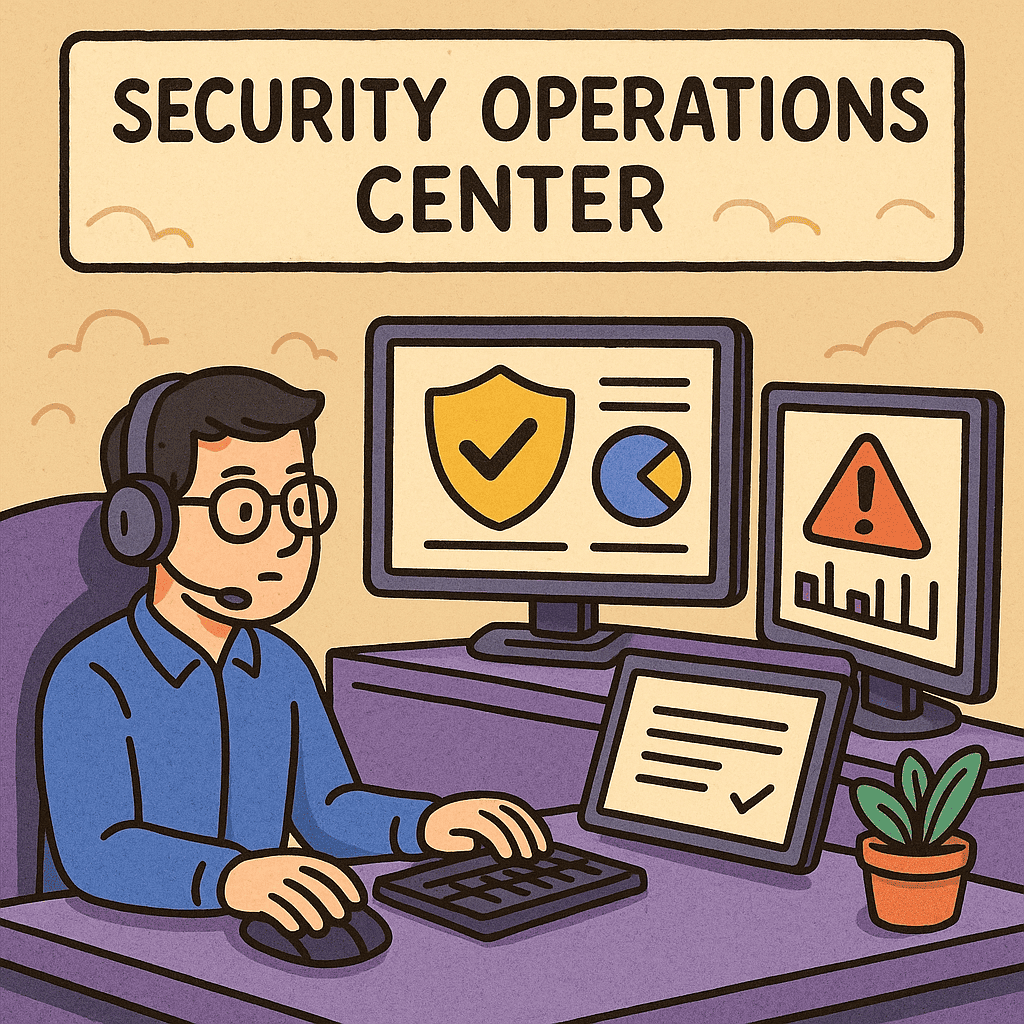Updated on October 22, 2025, by OpenEDR
Are you confident your organization is watching for cyber threats around the clock? A security operations center is the nerve center of a modern cybersecurity program, tasked with monitoring, detecting, and responding to incidents 24/7. For IT managers, cybersecurity leaders, and CEOs, understanding the full scope of a SOC is critical to keeping your business resilient, compliant and proactive.
In this guide we’ll explore what a security operations center is, why businesses need one, key components, staffing models, best practices, and actionable steps for deployment.
Defining the Security Operations Center
A security operations center (SOC) is a centralized organizational function or facility responsible for defending an organization’s information systems and infrastructure from security threats.
It brings together three essential pillars: people, processes, and technology. By continuously monitoring networks, endpoints, logs, cloud services and applications, it enables rapid detection and response to cybersecurity incidents.
Why Organizations Need a SOC
Modern cyber-risks make a SOC much more than a nice-to-have. It delivers value by:
Providing 24/7 monitoring & incident response – SOCs give continuous oversight so threats aren’t missed after hours.
Improving detection speed and accuracy – By correlating data across systems, SOCs reduce dwell time of attackers.
Enhancing compliance and governance – Regulatory frameworks increasingly expect organizations to demonstrate cyber-security operations capability.
Strengthening business resilience – A well-run SOC helps mitigate brand damage, data loss and operational disruption.
Core Functions of a SOC
1. Monitoring & Detection
Using tools like SIEM, EDR, network sensors and logs, the SOC continuously collects and analyses telemetry to detect threats and anomalies.
2. Incident Response & Remediation
Once a threat is identified, the SOC mobilizes workflows to investigate, contain, eradicate and recover from security incidents.
3. Threat Hunting & Intelligence
Proactive hunting for hidden threats and using intelligence feeds to anticipate emerging attack tactics are increasingly core capabilities.
4. Reporting & Compliance
The SOC also provides dashboards, metrics and compliance reports to leadership and regulatory bodies.
Key Components & Technology Stack
Every SOC relies on a blend of technologies and processes:
SIEM / XDR / SOAR platforms to aggregate, correlate and automate alerts.
EDR (Endpoint Detection & Response) agents on workstations, servers, mobile devices.
Network and cloud telemetry including firewalls, IDS/IPS, DNS logs.
Threat intelligence feeds to provide context on attacker behaviour.
Incident management & playbooks to ensure consistent, documented responses.
SOC Staffing & Delivery Models
Organizations can build SOCs in different models depending on scale and resources:
In-house SOC – Organization fully owns staffing, infrastructure, and operations.
Outsourced / MSSP (Managed Security Service Provider) – SOC operations are contracted to a third-party provider.
Hybrid / Virtual SOC – Mix of internal team and external augmentation (e.g., for overnight shifts or cloud coverage).
Roles in a SOC typically include analysts (Tier 1-3), incident responders, threat hunters, SOC manager and supporting engineers.
Best Practices for an Effective SOC
Define clear objectives & scope – Know what assets, environments and behaviours you are monitoring.
Establish metrics & KPIs – Such as mean time to detect (MTTD) and mean time to respond (MTTR).
Automate where possible – Use SOAR to reduce analyst fatigue and scale operations.
Enable continuous improvement – Post-incident reviews and tuning of playbooks ensure evolution.
Ensure integration and visibility – Your SOC must have visibility across endpoints, network, cloud, identity.
Maintain talent & training – Cyber talent shortage is real; invest in skills and retention.
Challenges & How to Overcome Them
While SOCs deliver value, they come with hurdles:
Alert fatigue – Too many false positives dilute focus. Use tuning and automation.
Skills gap – Demand for SOC analysts is high; consider outsourcing or augmenting with AI.
Tool sprawl and data silos – Unified platforms help reduce fragmentation.
Evolving attack surface – Cloud, remote work, IoT—all expand what the SOC must monitor.
Recognizing these challenges allows leadership to set realistic expectations and prioritize investments wisely.
How to Build or Enhance Your SOC
Here’s a phased roadmap for IT leaders and security executives:
Assessment: Evaluate current capabilities, asset inventory and threat exposure.
Design: Define SOC mission, team roles, processes, tools and scope.
Deploy: Implement core technologies (SIEM, EDR, SOAR) and hire/train staff.
Operate: Run 24/7 monitoring, incident response, hunting, and reporting.
Optimize: Continually tune detections, reduce noise, incorporate new telemetry, and align with business goals.
Whether starting from scratch or maturing an existing SOC, aligning with organizational risk and strategy is crucial.
SOC for Business Leaders: Strategic Impacts
For CEOs, founders and board-members, a SOC is not just a technical function—it’s a strategic investment. A well-run SOC helps:
Protect intellectual property and customer data
Safeguard brand reputation
Meet regulatory obligations (e.g., GDPR, HIPAA, PCI)
Enable growth with security assurance for customers and partners
From a business-impact standpoint, the SOC supports continuity, trust and competitive advantage.
Conclusion
In today’s cyber-threat landscape, knowing what is a security operations center is no longer optional—it’s fundamental. A mature SOC brings real-time detection and response, integrates technology with processes and talent, and aligns cybersecurity with business outcomes. For IT managers and security leaders, the decision isn’t just about setting up monitoring—it’s about building resilience.
👉 Ready to strengthen your security operations and stay ahead of threats? Register for a demo today and explore enterprise-grade security solutions.
FAQs
Q1: What does a SOC monitor?
A SOC monitors networks, endpoints, servers, applications, cloud services, user identity systems and logs.
Q2: What is the difference between SOC and NOC?
A NOC (Network Operations Center) focuses on network performance and availability; a SOC focuses on security-threat detection and response.
Q3: Can smaller organizations have a SOC?
Yes—through outsourced MSSP or virtual SOC models, smaller firms can access 24/7 security operations without huge internal investment.
Q4: What tools are essential for a SOC?
Key tools include SIEM, SOAR, EDR, threat intelligence feeds, network sensors, log management and automation platforms.
Q5: How do you measure SOC success?
Metrics such as MTTD, MTTR, number of incidents detected before impact, cost per incident, and compliance improvement are common.
